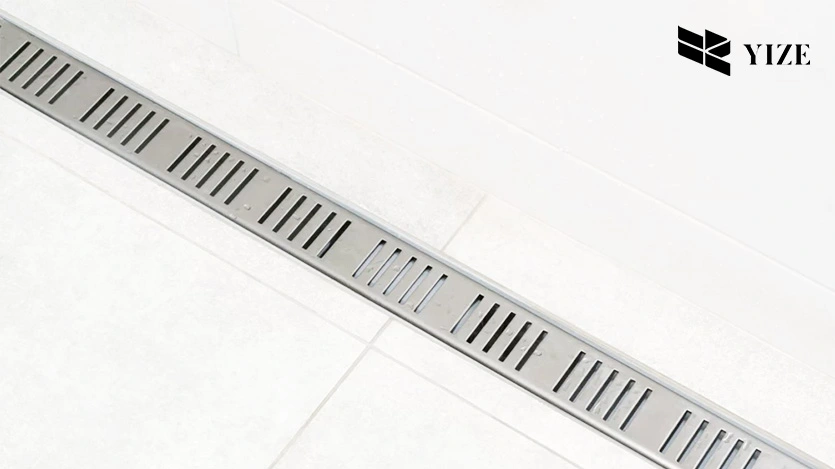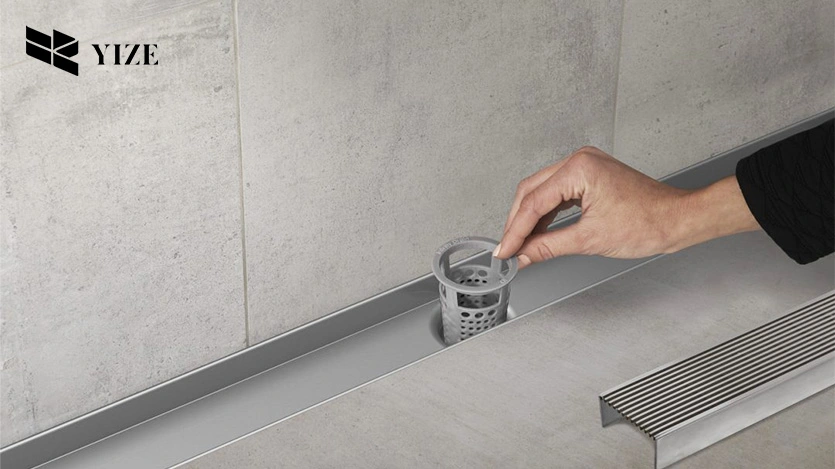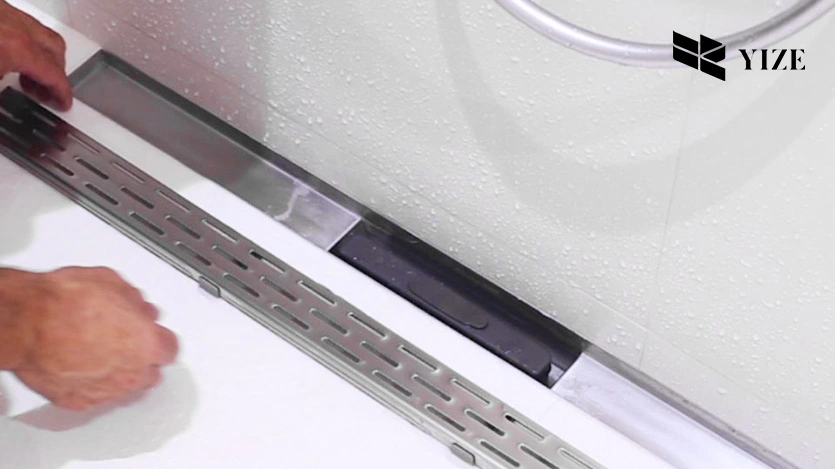
I. Introduction
It is very important to clean and maintain your composite linear drain properly to get the best results for the maximum time you use it. shown below are these drains, widely used indoors, especially in facilities such as bathrooms and kitchens, in managing water flow to eliminate pooling. If one maintains his drainage system well, then one can avoid the expensive exercise of repairing and replacing the damaged sections of the drain lines. In this guide, you will be able to learn how to effectively clean and maintain your composite linear drain so it will continue to perform its function.
II. Why Cleaning And Maintenance Is Important
1. Preventing Blockages
A composite linear drain takes a steady water flow rate through it. However, after some time, the shower walls, the remnants of soap and body hair, and other debris may accumulate on the surface and clog the drain. If not removed, stagnant water, a bad smell, and even water hurting your house could occur. Cleanliness also plays a critical role in preventing these from getting worse through regular cleaning.
2. Ensuring Longevity
Regular maintenance will help to ensure that the composite linear drain lasts longer than expected. It means that you do not risk a drain failure, hence keeping it neat and well-maintained greatly reduces the chances. That being said, composite materials are considered some of the most durable currently known to man, though like any complex system, they require occasional coddling to run like a charm. This is so because failure to maintain the formerly indicated systems will result in their low efficiency and expensive repairs in the future.
III. Essential Tools for Cleaning Composite Linear Drain

To clean your composite linear drain effectively, you’ll need a few essential tools:
1. List of Necessary Tools
●Gloves: Make sure to wear gloves as you work on it so that you don’t have to touch any dirty surfaces come into contact with any chemicals or navigate through sharp edges.
●Drain Grate Removal Tool: An implement uniquely suited to be used in heaving the drain grate to access the inside in the course of and for the purpose of this invention.
●Mild Detergent: Mild detergents are effective in cleaning surfaces to remove dirt, while other harsh substances compromise the composite material.
●Gutter Scoop: Used in regenerating the big particles from the drain channel.
●Garden Hose or Bucket of Water: For use in washing down the drain after the cleaning process.
●Soft Brush or Cloth: But for cleaning the inner surfaces of the drain to eliminate any deposit.
2. Safety Equipment to Consider
●Safety Goggles: Avoid having water or detergent come into contact with your eyes.
●Non-Slip Shoes: There is always a tendency to slip when you are around wet surfaces, wearing slip-on shoes can be avoided.
IV. How to Clean a Composite Linear Drain: Step-by-Step Guide
Follow these steps to clean your composite linear drain:
Step 1: Remove the Drain Grate
The very first step in the process is to remove the grate that usually covers the linear drain. This grate prevents large objects from falling directly into the drain; however, it must be removed to clean the drain well. To lift it off, use a grate removal tool very carefully.
Step 2: Rinse with Water
Once you manage to remove the grate, you can use water, from the garden hose, or a bucket of water to wash the inside of the drain. This will help to detach any detachable dirt such as dirt or soap scum making them more easy to wash.
Step 3: Clean with a Mild Detergent
Spray a light detergent into the inside of the drain then scrub with a soft brush or cloth the interior walls of the drain. Handle it softly to not cause the weathered surface to scrape the composite material.
Step 4: Check for Clogs
During cleaning, the system should be checked for blockage signs. If water is draining sluggishly, this may be due to a blockage that has to be removed. Larger debris causing the clog can be removed by using a gutter scoop or by one’s hands, albeit while wearing gloves. Rinse once more to make sure that the drain is clear of clogs.
Step 5: Dry and Replace
After making sure that the drain is clear of these blockages, make sure that anyone wetting the area using a towel and replace the drain grate.
V. How to Maintain Composite Linear Drain: Hints and Tips

Cleaning is only part of managing your composite linear drain effectively and regularly. Here are a few tips to help keep your drain in optimal condition:
●Monthly Inspection: This should be done, preferably once a month, to ensure there are no big chunks of food particles, lumps of debris, or slow flow.
●Avoid Harsh Chemicals: Fibre-reinforced composites may exhibit some reactive behavior toward specific chemical substances. You should avoid using strong detergents or use substances such as vinegar and baking soda where necessary.
●Rinse After Heavy Use: If your drain experiences higher-than-average water flow (like during meal time), it is a good idea to flush it to remove the debris.
●Consider a Drain Filter: Maintenance is easy if a basic drain filter is put in place to capture larger debris such as hair or food particles that should not get into the drain in the first place.
VI. Common Issues and Troubleshooting
There are some normal problems that may appear in your composite linear drain even if you clean it always: Here’s how to handle them:
1. Dealing with Stubborn Blockages
If your drain continues to remain clogged after trying the above methods, you will need to use a drain snake or a chemical drain cleaner usually meant for composite materials. Make sure to strictly follow the provided product guidelines to minimize damage to the drain.
2. Repairing Minor Damages
It is also common to find that the outer surface of the drain has some hairline cracks or is chipped slightly. They can be repaired most of the time with a composite repair kit. : They come along the package instructions for repairing the scratches and medium-small scale scratches; for more severe scratching, it is advised to consult a professional.
3. Addressing Overflow Problems
If your drain water overflows often, it may be that the drain is improperly placed or that there is a serious problem with the plumbing system. First, try to search for clogs. If that does not work, invite a specialist—a plumber.
VII. Why Choose YZDRAIN?
When choosing a composite linear drain, it is very important to do it comprehensively. YZDRAIN offers:
●High-Quality Standards: These products incorporate the best process technology to enhance their functions and last a long time.
●Durability: YZDRRAIN composite linear drains are designed to be durable and they can easily withstand normal use throughout the day.
●Customer Feedback: Our customers always satisfy our products because of their durability, convenience for maintenance, and effective usage.
VIII. Conclusion
The best way to clean and maintain your composite linear drain is easy when you have these vital tips. It is very important to follow the guidelines in this guide to see if your drain’s efficiency and functionality lasted for years. Fixing problems such as blockage or overflow not only results from regular usage but also from its continuous service to your drain. If you are looking for high-quality linear draining solutions that will prove durable and effective, turn to YZDRAIN.
Frequently Asked Questions (FAQs)
1. How often should I clean my composite linear drain?
Cleaning your drain is advised at least once a month or more often if the problem is slow draining or clogging.
2. Can I use bleach to clean my composite drain?
Thus, it is advisable to steer clear of tough chemicals, including bleach. Use gentle soaps or only vinegar or baking soda to clean the composite material since drastic cleaners will harm it.
3. What should I do if my drain is damaged?
Small cracks can be sealed with a composite repair kit, while large problems will require a professional intervention.
